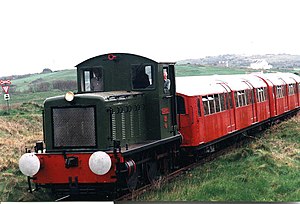Alderney Railway
| Alderney Railway | |||||||||||||||||||||||||||||||||||||||||||||
|---|---|---|---|---|---|---|---|---|---|---|---|---|---|---|---|---|---|---|---|---|---|---|---|---|---|---|---|---|---|---|---|---|---|---|---|---|---|---|---|---|---|---|---|---|---|
| Route length: | 3.2 km | ||||||||||||||||||||||||||||||||||||||||||||
| Gauge : | 1435 mm ( standard gauge ) | ||||||||||||||||||||||||||||||||||||||||||||
|
|||||||||||||||||||||||||||||||||||||||||||||

The Alderney Railway is a standard gauge railway on the channel island of Alderney , which was originally built for military reasons and is now used as a museum railway .
history
In the 1840s, extensive fortifications began to be built in the Braye Bay area . The building materials come from quarries at the eastern end of the island. After years of preparatory work, the British Admiralty opened the Alderney Railway in 1847 as the first state railway in Great Britain to carry out the transport of materials for the fortress construction.
In the course of the fortress construction, a port was built that includes a breakwater that was originally 1,430 meters long. Since the substructure of the breakwater had to be constantly renewed, the railway remained in operation even after the construction work was completed.
In 1854 the British royal couple visited the island and also toured the Alderney Railway, which was otherwise only used for freight traffic. The railway served its original purpose until 1921 when it was sold to Brookes Ltd. together with the quarries. was leased. Brookes, at that time the largest employer on Alderney, exported granite gravel for road construction and continued to supply the material for the maintenance of the breakwater.
After the German occupation in 1940, most of the track systems were dismantled and the route was partly used by light railways with a 600 mm gauge . After the withdrawal of the German troops in 1945, the standard gauge systems were rebuilt by the British Ministry of Defense and used for the maintenance of the breakwater. In 1958 the steam operation ended with the delivery of the first diesel locomotive . In the mid-1970s, responsibility for breakwaters and railways went to the Ministry of the Interior, where attempts were made to use the railway for tourism. The line was finally leased to the "Alderney Railway Society", which began operations on March 5, 1980.
Today, the tourist trains run regularly in the afternoon on weekends from Easter to the end of September, further trains are used in the summer and before Christmas. Travel time in one direction is 15 minutes.
Routing
The first section of the route, which is no longer used today, begins at the tip of the breakwater at Braye Bay and runs on its crown to the harbor. The route continues through the harbor towards St. Anne to today's terminus on Braye Road, where the trains of the museum train begin. The route leads at some distance to the shore along the coast past quarries and fortifications to the eastern tip of the island, where the railway ends in Mannez Quarry. The section of the route traveled today is about two miles long.
Rolling stock
There are hardly any sources about the use of vehicles before the German occupation. The use of a two-axle saddle tank locomotive built by Pecket & Sons and a number of simple two-axle side tippers for transporting goods is known.
After the end of the Second World War there were no more usable vehicles on Alderney. For the transport of materials, 24 American-made side-tipping cars and a small two-axle steam locomotive with a standing boiler were initially brought to Alderney. The steam locomotive was named "Molly", the dump cars were called "Yankees" because of their origin. In 1958 a two-axle diesel locomotive from Ruston Hornsby , also called "Molly", took over the operation. These vehicles were equipped with a central buffer coupling according to the American system. "Molly" is still there today, but cannot be used in passenger train services due to the clutch and brake design.
Museum passenger train operations began in 1980 with two Wickham small railroad cars, six of which have now reached the island. In 1982 a two-axle Bagnall steam locomotive called "JT Daly" was procured and used with two open passenger cars until the mid-1990s. Then the vehicles were handed over to Jersey because the steam locomotive was rarely used and too expensive to maintain. In 1984 another two-axle Drewry diesel locomotive came to Alderney. This locomotive was built at Vulcan in Newtown and used there as a works locomotive until the end of the locomotive construction. Since 1985 this locomotive named "Elizabeth" with the number D100 has carried the main load of the operation.
For passenger transport, two subway cars built in 1938 by the London Underground were procured in 1987 and pulled by a diesel locomotive on Alderney. Because of the harsh maritime climate, the condition of the wagons deteriorated noticeably, so that in 2000 they had to be retired and scrapped. As a replacement, two subway cars built in 1959 with the numbers 1044 and 1045 were procured from London, which have been in use since 2001 and are supposed to cope better with the climate due to the aluminum construction.
Due to inadequate loading facilities in the port, the transport of vehicles to and from the mainland is problematic, so that the diesel locomotives had to be delivered in individual parts. The subway cars were transported by army landing craft.
Web links
Individual evidence
- ^ Alderney Breakwater by M. Swift, from The Industrial Railway Record No. 52, pp. 170-173 (English), accessed April 17, 2015
